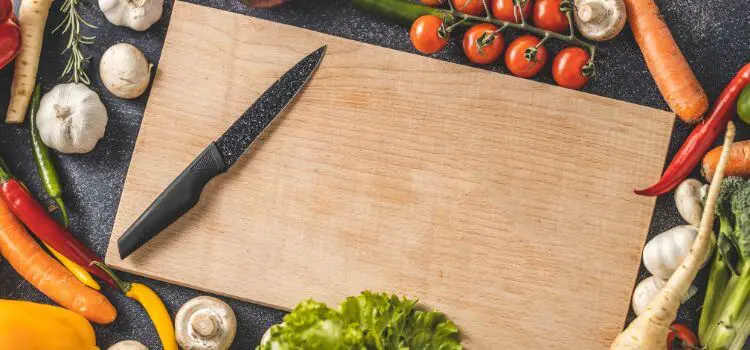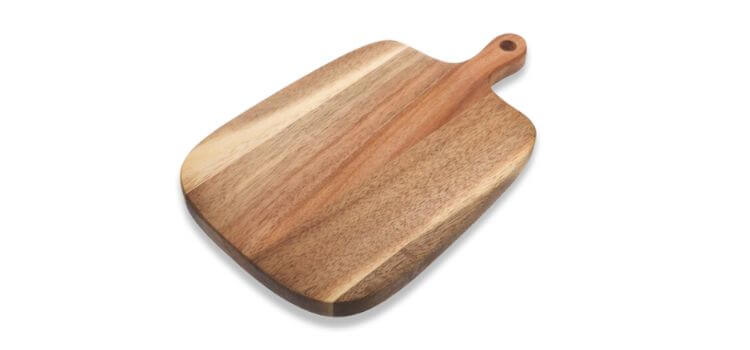As an Amazon Associate, I earn from qualifying purchases

In the world of kitchen essentials, cutting boards hold a special place, quietly aiding every chef and home cook in their culinary endeavors. While many materials are used for crafting these indispensable tools, wood remains a classic choice, celebrated for its excellent balance of durability and aesthetics.
Among the various woods available, hickory stands out for its reputation of strength and resilience. But is hickory the right choice for your cutting board? Let’s explore the qualities of hickory wood and determine whether it deserves a spot in your kitchen.
Hickory wood is well-known for its robust nature. Celebrated for its strength, this type of wood is often used in applications that require exceptional durability, such as tool handles and flooring. Its fine, straight grain and beautiful color variations—from pale beige to rich reddish brown—offer an appealing look that can complement any kitchen style. Additionally, hickory is dense and heavy, which can be both an advantage and a disadvantage depending on your needs.
Benefits of Using Hickory for Cutting Boards
Benefits of Hickory Cutting Boards:
- Durability:
- Hickory is known for its exceptional toughness, making it highly resistant to scratches and dents.
- Ideal for a kitchen environment, these boards can withstand heavy chopping, slicing, and dicing without significant wear, ensuring long-lasting reliability.
- Aesthetic Appeal:
- Hickory cutting boards feature attractive grain patterns and color variations that add natural beauty to your kitchen.
- Each board is unique, serving as both a functional tool and a decorative piece that enhances the overall ambiance of your cooking space.
- Moisture Resistance:
- The hardness of hickory means it is less likely to absorb moisture, helping to maintain a sanitary cutting surface.
- This property also ensures stability during use, providing a firm surface for cutting tasks.
Potential Drawbacks
Drawbacks of Hickory Cutting Boards:
- Knife Dulling:
- The hardness of hickory, while contributing to its durability, can be a downside for your knives. Over time, this excessive hardness can dull the sharp edges of your blades, necessitating more frequent sharpening. If you invest in high-quality knives, you’ll need to weigh whether the trade-off is worthwhile.
- Weight:
- Hickory cutting boards are heavier than many other types of wood due to their density. This can make them cumbersome to move, especially if you own a large board. If you often shift your cutting board from counter to sink or need to lift it for cleaning, the added weight could be a significant drawback.
- Maintenance Requirements:
- The density of hickory demands specific care. Its natural toughness means it can be unforgiving if not maintained properly. Regular oiling is crucial to prevent cracking, and you must avoid exposing the board to extreme temperatures or excessive moisture to preserve its structural integrity.
Comparison with Other Popular Woods

When comparing hickory to other popular woods like maple, walnut, and cherry, several differences emerge. Maple, for instance, is another durable option known for its resistance to bacteria and easy maintenance. Maple boards are typically lighter than hickory, making them easier to handle, but they may not offer the same level of scratch resistance.
Walnut cutting boards are famed for their rich, dark tone and aesthetic appeal. While walnut is softer than hickory, it is gentler on knives, which might appeal to those looking to preserve their blades’ sharpness. However, walnut requires more frequent maintenance to keep its beautiful appearance.
Cherry wood offers a warm reddish hue and is softer than both hickory and maple. While it has a unique aesthetic, it is more prone to scratching and requires careful handling. Its softness makes it less ideal for heavy-duty chopping but perfect for light cutting tasks.
Tips for Maintaining Hickory Cutting Boards
Proper maintenance is crucial to ensure the longevity of your hickory cutting board. Regular cleaning is the first step. After each use, wash the board with mild soap and warm water. Avoid immersing it in water, as prolonged exposure can lead to warping. Dry the board thoroughly after washing to prevent moisture from penetrating the wood.
Seasoning your hickory board with mineral oil or a specialized wood conditioner is essential. This process helps maintain the board’s moisture balance and prevents cracking by creating a protective barrier. Aim to oil your board at least once a month, or more frequently if you use it often.
To avoid damage, keep your hickory cutting board away from direct sunlight and extreme temperature changes. Use cutting board mats or pads to protect it from scratches when storing or stacking. These simple steps can significantly extend the life of your board.
How to Decide if Hickory is the Right Choice for You
Choosing a cutting board is a personal decision that depends on several factors. Consider your cooking habits first. If you frequently engage in heavy-duty chopping and need a board that can withstand intense use, hickory could be an excellent choice. However, if you prioritize knife sharpness and ease of handling, you might explore other options.
Your kitchen style is another consideration. Hickory’s natural beauty can complement various aesthetics, from rustic to contemporary. If visual appeal is important to you, hickory’s unique grain and color variations might be the perfect match.
Finally, consider your budget. Hickory boards can be more expensive than softer woods, but their durability might offer long-term savings by reducing the need for replacements. Weigh the initial investment against the potential longevity and performance benefits.
Conclusion
In conclusion, hickory cutting boards offer a compelling combination of durability and aesthetic appeal. Their robust nature makes them ideal for kitchens where heavy use is common, while their unique beauty adds a decorative element to your culinary space. However, the potential impact on knife sharpness, the board’s weight, and the specific maintenance required are factors to consider.
Ultimately, whether hickory is the right choice for you depends on your individual needs and preferences. For those who value strength and longevity in a cutting board, hickory can be a worthwhile investment. With proper care, a hickory cutting board can serve as a reliable kitchen companion, aiding in the creation of countless delicious meals and culinary memories.
FAQ
What wood should not be used for cutting boards?
Avoid using softwoods like pine and cedar for cutting boards. Their porous nature and softness make them prone to damage and bacteria accumulation. Additionally, they can impart unwanted flavors to food due to their high resin content, making them unsuitable for kitchen use.
Is hickory difficult to cut?
Hickory is a very hard and dense wood, making it challenging to cut and shape. Its toughness is beneficial for durability but requires specialized tools and techniques for woodworking. This hardness also translates to its resistance to wear, making it a long-lasting material for various applications.
What is hickory wood good for?
Hickory wood is prized for its strength and durability, making it ideal for tool handles, flooring, and furniture. Its attractive grain patterns and color variations also make it popular for decorative purposes. Additionally, hickory is used in smoking meats, imparting a rich flavor to food.
What type of wood cutting board is best?
Maple is often considered the best wood for cutting boards due to its fine grain, hardness, and resistance to bacteria. It provides a durable, sanitary surface for food preparation and complements most kitchen aesthetics with its light color and subtle grain patterns.
As an Amazon Associate, I earn from qualifying purchases